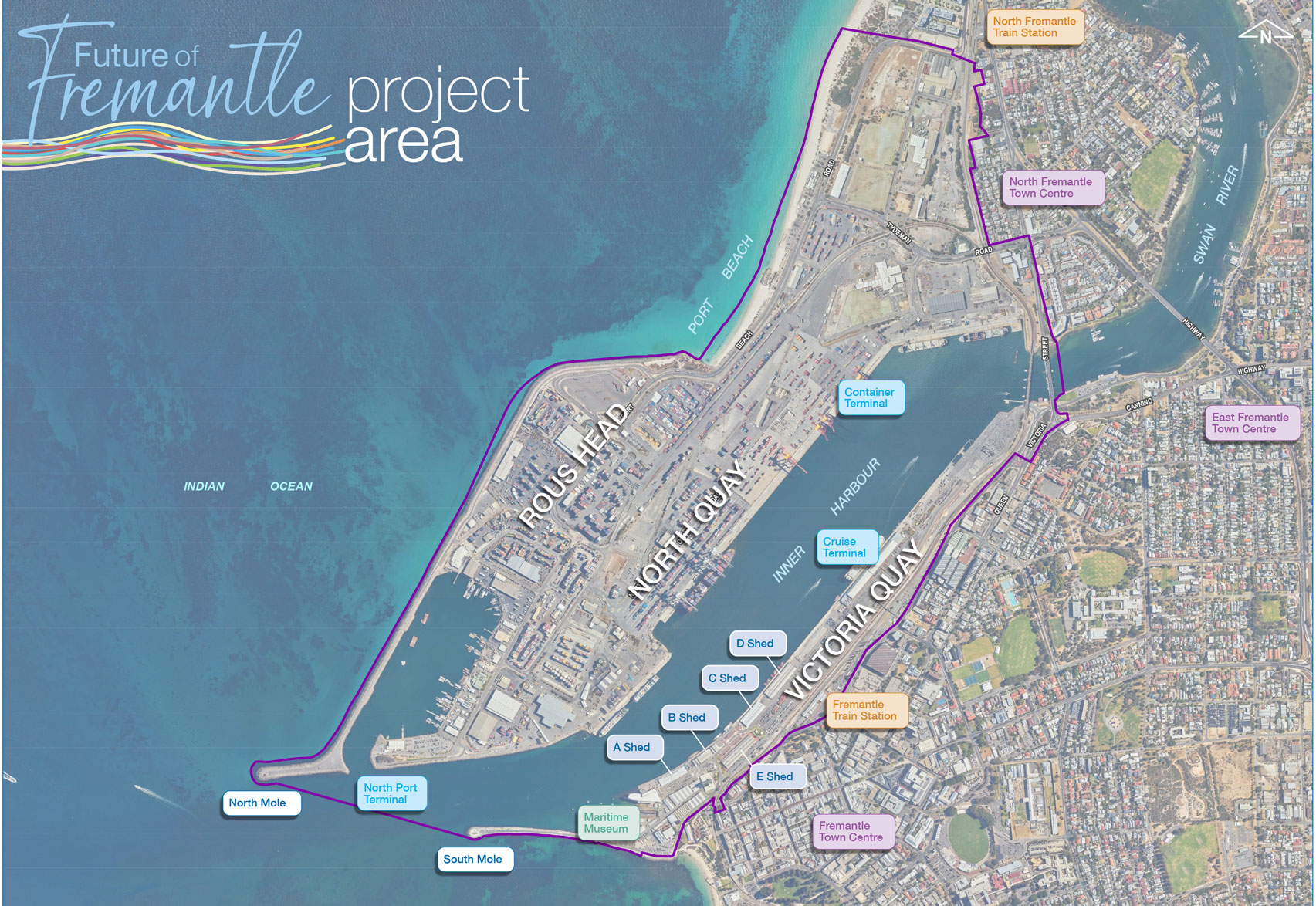What is the Future of Fremantle project?
Show more- The Future of Fremantle project worked closely with the community and other key stakeholders to develop a long-term vision (50 years) for the future redevelopment of the Fremantle harbour.
- Future of Fremantle is closely connected to the State Government’s Westport planning program to relocate container trade from Fremantle to Kwinana. Removing trade from the Port of Fremantle while retaining its status as a working port for cruise, visiting naval and recreational vessels, will unlock 260 hectares of prime inner urban land in Fremantle to support WA’s growing population.
- The Government appointed the Future of Fremantle Planning Committee, a sub-committee of the Western Australian Planning Commission, to oversee the process. The Future of Fremantle Planning Committee was supported by an Aboriginal Reference Group, a Project Reference Group, the Department of Planning, Lands and Heritage, a multi-disciplinary consultant team and cultural advisory consultants.
- Following extensive community consultation, three draft scenarios for future redevelopment were created and offered to the community for further comment. Community feedback on the draft scenarios helped inform the preferred scenario which is now reflected in the endorsed Future of Fremantle Place and Economic Vision.
What is the Future of Fremantle Place and Economic Vision?
Show more- The Future of Fremantle Place and Economic Vision aims to create a place that embodies the spirit of Fremantle – resilient, adaptable, hard-working and welcoming – while also capturing the important cultural significance the area, Walyalup, has for Aboriginal people.
- The Place and Economic Vision has five key goals:
- Grow an economy for the future – catalytic infrastructure to support the development of high-value, diversified industry clusters and new jobs, with a focus on those sectors that will perform well in Fremantle, such as tourism, culture and the arts, maritime industries, education, and research and development.
- Reflect Freo’s/Walyalup’s identity - begin with Country, history and heritage to enrich identity and create new lifestyle opportunities.
- Reconnect land and water - an abundance of green open spaces, natural landscapes and accessible river edges and coastal destinations.
- Diversity and health - high-intensity and mixed land use to support healthy, accessible and connected communities.
- Walkable and well-connected - transport infrastructure to support the land use vision and 70% sustainable (active and public transport) mode-share target.
- At project completion, the Vision has the capacity to deliver:
- 45,000 additional jobs within diversified industry sectors
- 20,000 diverse new homes including social housing
- 55,000 new residents
- $13.6 billion in Gross State Product annually
- a prosperous, globally significant district that would attract international commercial and investment opportunities.
- The Vision aligns with the Government’s economic diversification goals, providing a strategic opportunity to support the Western Trade Coast and attract investment for industries such as tourism, research and development, blue economy, green industries and creative industries.
- The Vision proposes the harbour would retain some of its working functions, with cruise ships, ferries, visiting naval and recreation vessels to remain.
What area is under consideration?
Show more- The project area consists of more than 260 hectares of land (370 hectares including waterways) and approximately 10 kilometres of rare river and ocean frontage. It encompasses Victoria Quay, North Quay, Rous Head and North Fremantle land situated north of Tydeman Road, between the Fremantle passenger line and coast.
What was the process and who was consulted?
Show more- The Future of Fremantle project was conducted in three phases:
- Phase 1 Place and Economic Directions, comprising technical investigations, case study research, and preliminary engagement.
- Phase 2 Visioning and Preliminary Scenarios, comprising collaborative visioning, modelling and design, including community consultation and feedback.
- Phase 3 Preparation of draft Place and Economic Vision for consideration by the State Government.
- Extensive engagement over 12 months and involving more than 1,000 people and more than 150 hours of stakeholder interaction from community, industry and government helped to inform the Future of Fremantle Place and Economic Vision.
- A key focus was on gathering the insights from Aboriginal Elders to understand the cultural significance of the Walyalup area for Aboriginal people and their aspirations for the future, as well as the perspectives of young people who will benefit from the site’s redevelopment.
What is the timing for the redevelopment?
Show more- The Future of Fremantle project is closely linked to Westport and has explored the many exciting possibilities that can be achieved following the relocation of port trades, including the future use of the harbour precinct land and waterways, and future jobs.
- The scale of the project would see the redevelopment staged over several decades with timeframes for implementation to be guided in part by the timing for the relocation of trades from the harbour as this will determine when land and waterways become available for repurposing.
What happens next?
Show more- The Vision is an important first step in a longer program of work to progress the redevelopment.
- Additional studies, investigations and more detailed planning will be undertaken to inform future investment decisions to support realisation of the Future of Fremantle Vision.
- This will provide many future opportunities for the community and stakeholders to participate in the planning and delivery of the Vision for this once-in-a-generation opportunity.



